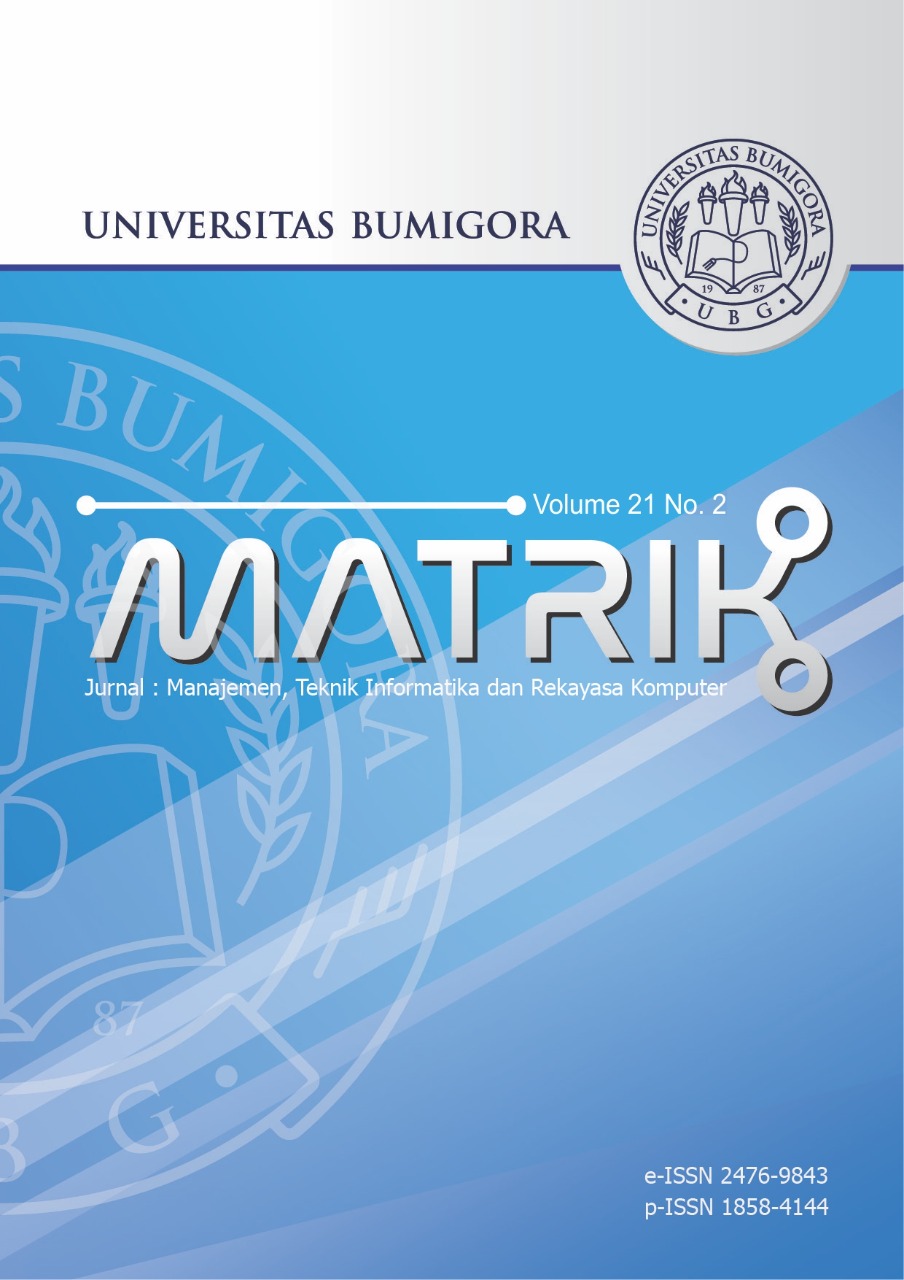Analyzing the use of Social Media by Fashion Designers with K-Means and C45
Abstract
Social media is one part of digital marketing that is used for the development of marketing business products known as social-marketing. The use of social media as social marketing is still managed conventionally and has not implemented business social media. This study was conducted to analyze the clusters and classifications of the use of social media by fashion designers in West Sumatra in marketing their products. This analysis uses the k-Means algorithm and c45 uses the Rapidminer application for the fashion designer industry in West Sumatra. Data is collected from Instagram and Facebook of fashion designers. The data analyzed by K-Means resulted in 3 clusters of social media use, namely 3 less active clusters, 12 active clusters and 1 very active, then classification using the C45 method resulted in a decision tree that described the most and the least in using social media. This study resulted in grouping and classifying variables from whether or not the use of social media in social marketing for the fashion designer industry players in West Sumatra was good or not. The results of this study can be used as a reference for developing integrated marketing for West Sumatra fashion designers.
Downloads
References
[2] M. Hartemo, “Email marketing in the era of the empowered consumer,” J. Res. Interact. Mark., vol. 10, no. 3, pp. 212–230, 2016, doi: 10.1108/JRIM-06-2015-0040.
[3] K. J. Trainor, J. Andzulis, A. Rapp, and R. Agnihotri, “Social media technology usage and customer relationship performance: A capabilities-based examination of social CRM,” J. Bus. Res., vol. 67, no. 6, pp. 1201–1208, 2014, doi: 10.1016/j.jbusres.2013.05.002.
[4] T. H. Song, S. Y. Kim, and J. Y. Kim, “The dynamic effect of customer equity across firm growth: The case of small and medium-sized online retailers,” J. Bus. Res., vol. 69, no. 9, pp. 3755–3764, 2016, doi: 10.1016/j.jbusres.2015.12.067.
[5] G. Piccoli, T. W. Lui, and B. Grün, “The impact of IT-enabled customer service systems on service personalization, customer service perceptions, and hotel performance,” Tour. Manag., vol. 59, pp. 349–362, 2017, doi: 10.1016/j.tourman.2016.08.015.
[6] K. C. Chang, “How travel agency reputation creates recommendation behavior,” Ind. Manag. Data Syst., vol. 115, no. 2, pp. 332–352, 2015, doi: 10.1108/IMDS-09-2014-0265.
[7] E. W. T. Ngai, K. L. K. Moon, S. S. Lam, E. S. K. Chin, and S. S. C. Tao, “Social media models, technologies, and applications: An academic review and case study,” Ind. Manag. Data Syst., vol. 115, no. 5, pp. 769–802, 2015, doi: 10.1108/IMDS-03-2015-0075.
[8] H. H. Chang, K. H. Wong, and P. W. Fang, “The effects of customer relationship management relational information processes on customer-based performance,” Decis. Support Syst., vol. 66, pp. 146–159, 2014, doi: 10.1016/j.dss.2014.06.010.
[9] T. A. Monteiro, A. C. Giuliani, N. K. Pizzinatto, and E. Larios-Gomez, “Managing the digital consumer: insights from Brazil and Spain,” J. Manuf. Technol. Manag., vol. 30, no. 8, pp. 1196–1215, 2019, doi: 10.1108/JMTM-12-2017-0272.
[10] I.-L. Kuo, “The effectiveness of environmental interpretation at resource-Sensitive tourism destinations,” Int. J. Tour. Res., vol. 4, no. 2, pp. 87–101, 2002, doi: 10.1002/jtr.362.
[11] P. Foroudi, S. Gupta, A. Nazarian, and M. Duda, “Digital technology and marketing management capability: achieving growth in SMEs,” Qual. Mark. Res., vol. 20, no. 2, pp. 230–246, 2017, doi: 10.1108/QMR-01-2017-0014.
[12] G. Alfian, M. F. Ijaz, M. Syafrudin, M. A. Syaekhoni, N. L. Fitriyani, and J. Rhee, “Customer behavior analysis using real-time data processing: A case study of digital signage-based online stores,” Asia Pacific J. Mark. Logist., vol. 31, no. 1, pp. 265–290, 2019, doi: 10.1108/APJML-03-2018-0088.
[13] L. Choi and S. Lotz, “Motivations leading to customer citizenship behavior in services: scale development and validation,” J. Consum. Mark., vol. 33, no. 7, pp. 539–551, 2016, doi: 10.1108/JCM-01-2016-1683.
[14] C. Wirawan, E. Khudzaeva, T. H. Hasibuan, Karjono, and Y. H. K. Lubis, “Application of Data mining to Prediction of Timeliness Graduation of Students (A Case Study),” 2019 7th Int. Conf. Cyber IT Serv. Manag. CITSM 2019, pp. 18–21, 2019, doi: 10.1109/CITSM47753.2019.8965425.
[15] J. Y. M. Kang and J. Kim, “Online customer relationship marketing tactics through social media and perceived customer retention orientation of the green retailer,” J. Fash. Mark. Manag., vol. 21, no. 3, pp. 298–316, 2017, doi: 10.1108/JFMM-08-2016-0071.
[16] C. Satria and A. Anggrawan, “Aplikasi K-Means berbasis Web untuk Klasifikasi Kelas Unggulan,” Matrik J. Manajemen, Tek. Inform. dan Rekayasa Komput., vol. 21, no. 1, pp. 111–124, 2021, doi: 10.30812/matrik.v21i1.1473.
[17] K. M. Yazdi, A. M. Yazdi, S. Khodayi, J. Hou, W. Zhou, and S. Saedy, “Improving Fake News Detection Using K-means and Support Vector Machine Approaches,” vol. 14, no. 2, pp. 38–42, 2020.
[18] J. Majewska and S. Truskolaski, “Cluster-mapping procedure for tourism regions based on geostatistics and fuzzy clustering: example of Polish districts,” Curr. Issues Tour., vol. 22, no. 19, pp. 2365–2385, 2019, doi: 10.1080/13683500.2018.1467883.
[19] G. Chandrarathne, K. Thanikasalam, and A. Pinidiyaarachchi, “A Comprehensive Study on Deep Image Classification with Small Datasets,” Lect. Notes Electr. Eng., vol. 619, no. 7, pp. 93–106, 2020, doi: 10.1007/978-981-15-1289-6_9.
[20] Y. Alkhalifi, A. Zumarniansyah, R. Ardianto, N. Hardi, and A. E. Augustia, “Comparison of Naive Bayes Algorithm and C.45 Algorithm in Classification of Poor Communities Receiving Non Cash Food Assistance in Wanasari Village Karawang Regency,” J. Techno Nusa Mandiri, vol. 17, no. 1, pp. 37–42, 2020, doi: 10.33480/techno.v17i1.1191.
[21] M. Irfan, N. Lukman, A. A. Alfauzi, and J. Jumadi, “Comparison of algorithm Support Vector Machine and C4.5 for identification of pests and diseases in chili plants,” J. Phys. Conf. Ser., vol. 1402, no. 6, 2019, doi: 10.1088/1742-6596/1402/6/066104.
[22] S. Dwiasnati and Y. Devianto, “Utilization of Prediction Data for Prospective Decision Customers Insurance Using the Classification Method of C.45 and Naive Bayes Algorithms,” J. Phys. Conf. Ser., vol. 1179, no. 1, 2019, doi: 10.1088/1742-6596/1179/1/012023.
[23] W. Wiguna and D. Riana, “Diagnosis of Coronavirus Disease 2019 (Covid-19) Surveillance Using C4.5 Algorithm,” J. Pilar Nusa Mandiri, vol. 16, no. 1, pp. 71–80, 2020, doi: 10.33480/pilar.v16i1.1293.
[24] Y. Doǧan, F. Dalkiliç, D. Birant, R. A. Kut, and R. Yilmaz, “Novel Two-Dimensional Visualization Approaches for Multivariate Centroids of Clustering Algorithms,” Sci. Program., vol. 2018, 2018, doi: 10.1155/2018/9253295.
[25] M. A. Abdillah and A. Setyanto, “Implementasi Decision Tree Algoritma C4 . 5 Untuk Memprediksi Kesuksesan Pendidikan Karakter,” vol. XV, pp. 59–69, 2020.
[26] I. N. Budi, I. Ranggadara, I. Prihandi, N. R. Kurnianda, and Suhendra, “Prediction using C4.5 method and RFM method for selling furniture,” Int. J. Eng. Adv. Technol., vol. 9, no. 1, pp. 535–541, 2019, doi: 10.35940/ijeat.A9665.109119.
[27] S. Datta, S. Bhattacharjee, and S. Das, “Clustering with missing features: a penalized dissimilarity measure based approach,” Mach. Learn., vol. 107, no. 12, pp. 1987–2025, 2018, doi: 10.1007/s10994-018-5722-4.
[28] A. L. N. Fred and A. K. Jain, “Combining multiple clusterings using evidence accumulation,” IEEE Trans. Pattern Anal. Mach. Intell., vol. 27, no. 6, pp. 835–850, 2005, doi: 10.1109/TPAMI.2005.113.

This work is licensed under a Creative Commons Attribution-ShareAlike 4.0 International License.


.png)













